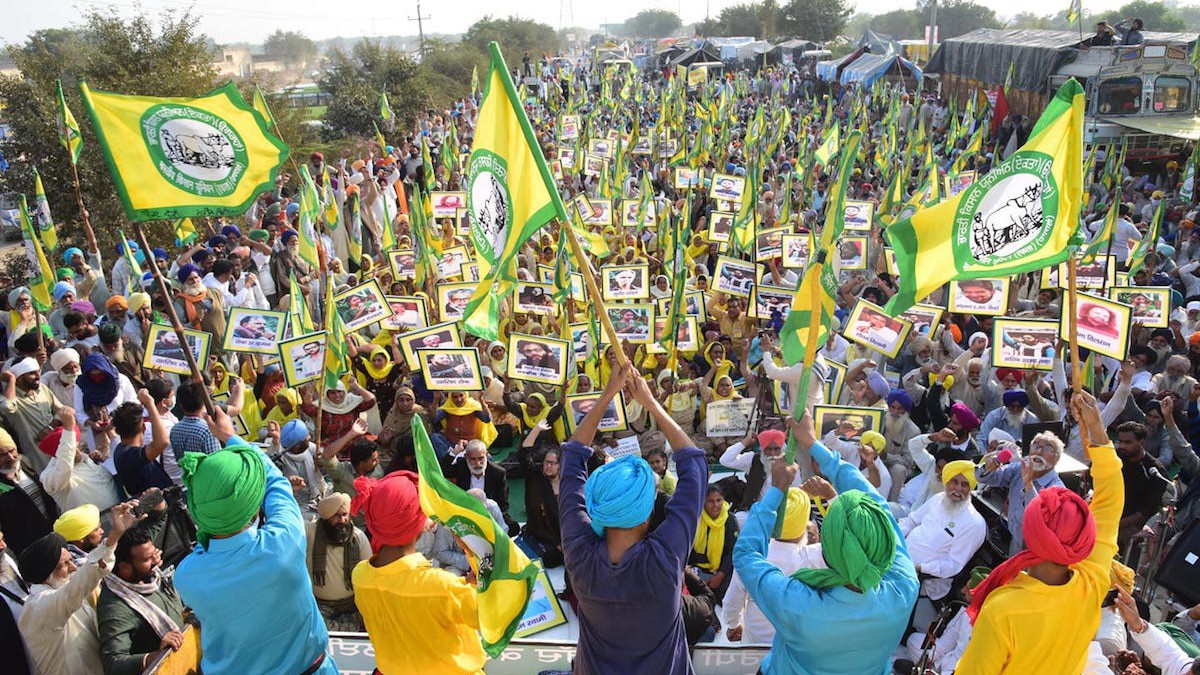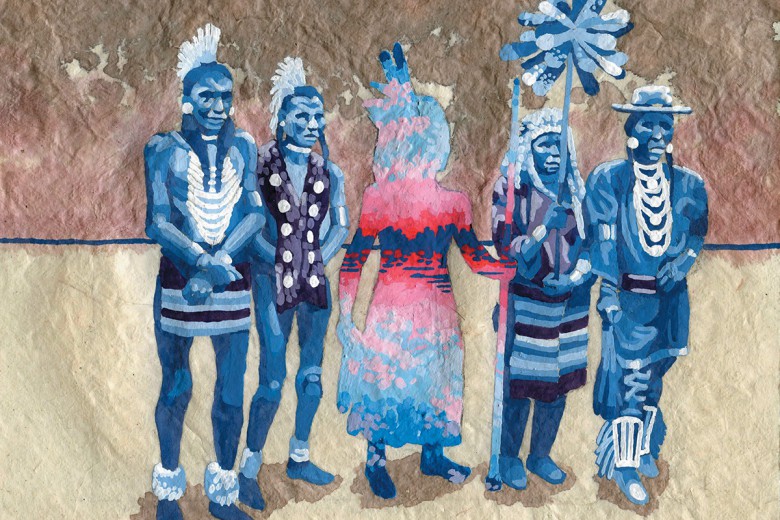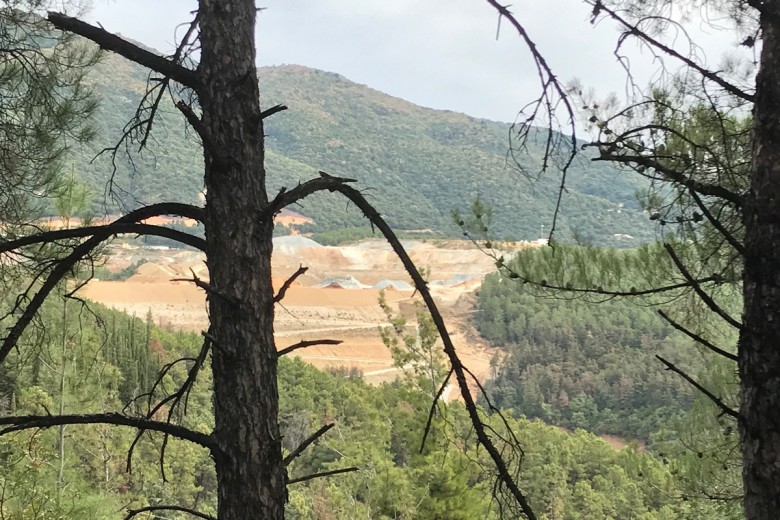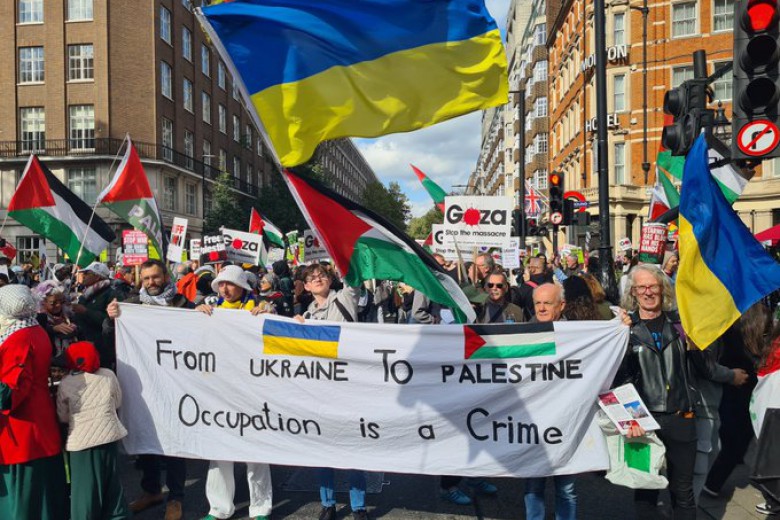“I will definitely go to Singhu [to] sit with farmers,” declared Nodeep Kaur, a 25-year-old Dalit labour rights activist, upon her release from jail, where she had been held for over one month and sexually assaulted in February 2021. Kaur had become a living symbol of the slogan “kisaan mazdoor ekta zindabad” (“long live farmer-worker unity”) and, like hundreds of detained political prisoners, jail would not deter her from rejoining the farmers’ protests.
Since September 2020, tens of thousands of farmers and farm labourers and over 40 unions have been waging resistance to three agricultural farm bills in India. They have been camping at the borders of Delhi, the country’s capital. Denounced as “Modi’s Black Laws,” these bills deregulate the agricultural sector, dismantle the mandi system (the state-regulated local market), and enable private corporations to take over food supply chains. The sustained presence, immense scale, and diverse solidarities in the farmers’ protest have shaken the legitimacy of Prime Minister Narendra Modi, the ruling Bharatiya Janata Party, and Hindu fascist-capitalist ideology. As historian Navyug Gill writes, “These protests are no ordinary expression of grievance. What the world is witnessing in Punjab is a grassroots popular upsurge that has the potential to transform the political landscape of India.”
In a country marred by growing capitalist privatization, imperial ambitions, Hindutva fascism, and patriarchal and caste oppression, these seeds of co-resistance cannot be underestimated.
As farmer unions point out, the protest against the new farm bills occurs within a persistent agrarian crisis, especially in the state of Punjab. Punjab (ਪੰਜਾਬ, land of the five rivers) is colloquially known as India’s breadbasket, producing the majority of the country’s grains but with nearly 86 per cent of farming households under debt. For the past three decades, a concerted neoliberal attack has privatized agriculture and inserted domestic agricultural production into global capitalist markets. The result, as Shreya Sinha writes, is that “small farmers are in deep crisis due to the small size of landholdings, unequal access to financial and infrastructural resources and indebtedness.” It places Punjab at the epicentre of farmer suicides, with one study pegging the number at 16,606 farmer and farm labourer suicides in the state over 15 years. Nearly three-quarters of farmers who took their own lives owned less than two hectares of land. Many of the farm labourer suicides are those of landless Dalit labourers, made precarious and exploitable as a result of violent caste hierarchy and the concentration of land ownership among savarna upper castes.
The farmers at the protest in Delhi have endured a freezing winter, risk of COVID transmission, draconian state repression, internet shutdowns, and media defamation. When the farmers first arrived in Delhi, they broke down concrete barricades while facing water cannons. Through the months, Delhi’s borders have been fortified with warlike infrastructure: barbed wire, drones, and walls. In an escalating crackdown, there have been at least 115 arrests, including of journalists on serious charges of sedition. The state and corporate media’s responses – which include targeted suppression of Sikh advocacy, Indian nationalist smears about farmers being funded by “Khalistani separatists,” and the escalation of anti-Sikh social media hashtags – all carry haunting echoes of the genocide of Sikhs in 1984 and the decades-long counter-insurgency that resulted in the mass killings and enforced disappearances of tens of thousands of Sikhs.
As historian Navyug Gill writes, “These protests are no ordinary expression of grievance. What the world is witnessing in Punjab is a grassroots popular upsurge that has the potential to transform the political landscape of India.”
There are many overlapping contours and emergent solidarities in the farmers’ protest. Farmer widows and women farmers are staking out a leadership role, refusing to be relegated to the kitchens of the protest sites. Wearing yellow dupattas to represent the bright colour of mustard fields, many are articulating an explicitly feminist politics. As 74-year-old Jasbir Kaur put it, “This is not just the men’s protest. We toil in the fields alongside the men. Who are we – if not farmers?” The Dalit-led Zameen Prapti Sangharsh Committee, which legitimately challenges upper caste and landowning farmers, has expressed support for and joined the farmers’ protest. Communist farmers’ unions are joining with naujawan jathebandies (youth-led Sikh organizations) to debate tactics, leadership, and relationship to the Indian state.
Like all protracted uprisings, these contradictions are being wrestled with in the material and embodied terrain of relationships – while literally facing down the state and building the world anew. In a country marred by growing capitalist privatization, imperial ambitions, Hindutva fascism, and patriarchal and caste oppression, these seeds of co-resistance cannot be underestimated.
Perhaps what is most inspiring about the farmers’ protest is the astoundingly large-scale logistical operation created to sustain the protest and surrounding communities. Free food is prepared and distributed from dawn to dusk, rooted in the Sikh principles of seva (service) and langar (food prepared in a Gurudwara community kitchen for all, regardless of religion, caste, gender, or economic status). Homeless and orphaned children are welcomed and fed throughout the day, and impromptu schools and learning spaces have opened to support their education. Laundry facilities and libraries with free books are popping up throughout, health care is accessible for all, tents and blankets are provided, clothes and necessities are offered through a free “kisaan mall,” stages host political education and entertainment, building groups and cleaning crews perform essential labour, and a night safety patrol ensures that no one is harmed while sleeping. The farmers’ protests are a prefigurative window with an ethical orientation and a political vision that is powerfully illuminating a path for us all.







